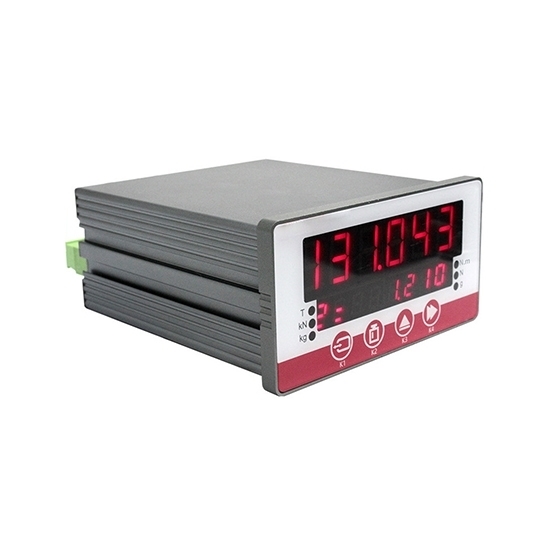
- Stock: In Stock
- Model: RDDLZ-DPM-DY800
- Weight: 1.00
- SKU: RDDLZ-DPM-DY800
Available Options
A 6 digit display controller is a device designed to control and drive a 6 digit display unit, which can cooperate with load cells, force sensors and weighing sensors to use. It serves as the interface between the display unit and an external system, such as a microcontroller or a computer.
Specification
- Model: RDDLZ-DPM-DY800 (Click it to view user manual)
- Power Supply Voltage: 10~30V DC
- Measurement Accuracy: <0.01%
- Measuring Speed: 5~320Hz
- Temperature Drift: <10ppm
- Display Scale: - 99999~999999
- Transmission Output: 0~10V, 4-20mA
- Communication Rate: 2400~115200
- Switch Output: 6-Way Relay Normally Open Node Output
- Switch Input: 2-Way Open Input
- Node Drive Capability: 3A/250V AC or 30V DC (Resistive Load)
- Measurement Channel: 5V Power Supply
- Working Environment: - 20~ 70°C
- Relative Humidity: <90% (No Condensation)
Note: You can use software + RS485 communication cable to log/record the data on a PC.
Dimension (Unit: mm)
Key Description
| key | K1 | K2 | K3 | K4 |
| Key Frame | Long press to enter parameter modification | Long press to enter calibration | Page turning | Long press to press the zero clearance |
| Parameter Modification | Save and go to the next parameter | Quit | Add | Right shift |
| Demarcate | Out | Calibration factor | / | Clear |
| Interface Testing | Select next function | Out | Output modification | Select |
Tips: How does a 6 digit display controller work with load cells?
A 6-digit display controller is typically used to interface with load cells for measuring weight or force. Load cells are transducers that convert a physical force into an electrical signal. The display controller receives this electrical signal from the load cells and processes it to provide a readable weight or force measurement on a 6-digit display. How a 6-digit display controller works with load cells?
- Load Cell Interface: The load cells are connected to the display controller through appropriate wiring. Load cells typically have multiple wires for power supply and signal transmission. The exact wiring configuration depends on the specific load cell and display controller being used.
- Amplification and Signal Conditioning: The electrical signal generated by the load cells is usually very weak and needs amplification and conditioning for accurate measurement. The display controller includes an amplifier and signal conditioning circuitry to strengthen and stabilize the load cell signal. This ensures that the measured weight or force is accurate and reliable.
- Analog-to-Digital Conversion: After amplification and conditioning, the analog signal from the load cells is converted into a digital format suitable for processing by the display controller. An analog-to-digital converter (ADC) is employed for this purpose. The ADC samples the analog signal at regular intervals and converts it into a digital value that represents the weight or force being measured.
- Data Processing: Once the analog signal is converted into a digital format, the display controller processes the data to calculate the weight or force value. This may involve applying calibration factors, performing linearization, and implementing any necessary algorithms for the specific load cell and measurement requirements. The processed data is typically stored in the controller's memory for display purposes.
- Display Output: The display controller drives the 6 digit display to show the measured weight or force value in a human-readable format. The display may be comprised of seven-segment LED displays or other suitable technologies. The controller updates the display continuously or at regular intervals to reflect any changes in the measured value.
